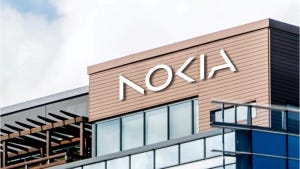Enterprise FMC: Death of the Desk Phone?
New approaches to FMC may finally enable enterprises to eliminate the unloved desk phone and put mobile phones in the hands of all their workers.
July 24, 2007

Mobile phones are, without question, as indispensable as email or IM to business communications, yet there are relatively few tools available to enterprises to allow them to control mobile costs, audit usage, and ensure regulatory compliance. Moreover, the high costs of cellular, combined with a lack of integration with corporate data resources, place an artificial limit on the pervasiveness of mobility in the enterprise, according to the latest Unstrung Insider report Fixed/Mobile Convergence: The Enterprise Opportunity.
To address these shortcomings, a number of publicly owned vendors and venture-backed startups are developing enterprise-centric fixed/mobile convergence (FMC) systems that aim to extend business communication applications out into the cellular network and, at the same time, pull mobile devices deeper into the IT department's orbit.
Typically based on client/server architectures, consisting of smartphone software and an FMC gateway, the idea is to offer converged services to both fixed and mobile devices independently of the mobile operator. The starting point is cellular extensions to the corporate PBX to enable features such as short-code dialing and call transfer; from there, more advanced data-oriented services can be added, such as visual voicemail and integrated IM and presence. Ultimately, this strategy will enable deeper integration with line-of-business applications, such as customer relationship management, sales, or inventory applications.
The expectation is that, by giving CIOs greater control over mobile users, enterprise FMC will make mobility more affordable for a greater portion of the employee base and therefore deliver large aggregate productivity and cost-saving benefits. Mobiles could one day even replace desk phones for the "average" office worker, at a stroke eliminating all the costs associated with LAN engineering to support VOIP and redundant investment in often rarely used fixed-line phones.
We've heard all about the mobile-only enterprise several times before, of course. For enterprise FMC to truly succeed this time, the industry must grapple with a host of challenges, including:
Client Software: Designing stable, usable client software that runs on popular mobile operating systems and handsets is undoubtedly the greatest challenge facing FMC developers. One key strategic decision is whether to build a full-featured client with its own look and feel, or whether to go for a lighter, transparent client that uses the native capabilities of the device.
Call Control: Enterprise FMC systems need a way to communicate between client and server. At a minimum, most systems can fall back on dual-tone multi-frequency signaling for basic functionality such as call transfer, but more advanced services are enabled by sending signaling over the 3G, EDGE, or WLAN data channel. Most vendors are moving towards SIP, but OnRelay Ltd. , which claims broadly applicable patents in this area (and incidentally, has one of the slickest demo and client software offerings on the market), is using its proprietary mobile-optimized Telephony Internetworking Protocol (TINP).
Unified Communications: The potential to combine telephony services with corporate data should be the cornerstone of any enterprise FMC deployment. It starts simply with features such as unified call logs or access to corporate directories, and then evolves to integrate corporate messaging and presence. Established PBX vendors such as Cisco Systems Inc. (Nasdaq: CSCO) and Avaya Inc. are jumping on this opportunity as the second coming of unified communications, while privately held FirstHand Technologies , which supplies OEM software to PBX makers NEC Corp. (Tokyo: 6701), 3Com Corp. (Nasdaq: COMS) and Nortel Networks Ltd. , is also pursuing this strategy.
Data Integration: A different twist on data integration comes from BlackBerry , which is looking to integrate FMC with its BlackBerry Enterprise Server and reap the concomitant security and management benefits. Startup Telepo Inc. , which OEMs to Ericsson AB (Nasdaq: ERIC), sees itself not so much as a voice solution, but as a "routing engine" that links mobile user identities to enterprise applications, whether a voice PBX, a CRM system, or both.
Wireless LAN: Contrary to popular belief, wireless LAN is not a prerequisite for enterprise FMC, and the majority of deployments today don't use it. Nevertheless, with its importance set to increase over time, support for WLAN is essential. One vendor pushing hard on this front is Siemens Communications Group , which recently introduced its SIP-based Mobile Connect Appliance, saying the majority of its WLAN customers already run VOIP. Another is DiVitas Networks Inc. , which has partnerships with several WLAN vendors and sees the technology as critical to enabling a disruptive FMC business model.
Carrier Integration: The thorny issue of how best to work with mobile carriers (if at all) is a perennial concern for enterprise FMC players. By integrating with the carrier's core network, either as an IN server via SS7 or as an IMS application server, service performance can be improved and more basic handsets can be supported. On the other hand, it's going to take a long time for mobile operators to really begin pushing this concept, and advanced services will be restricted to devices attached to a single carrier's network. One example of a startup firmly behind carrier integration is Tango Networks Inc.
How FMC is actually delivered to enterprise customers is also critical. While most business have in-house teams to run the PBX and desk phones, it's unlikely they'd want to take on the task of supporting thousands of smartphones running third-party client software for an application as critical as voice.
One solution could be outsourcing to a managed service provider, which could be a systems integrator, a wireline service provider, or – more likely – an integrated wireline/wireless operator. In this way, enterprise FMC applications that today focus on the interests of vendors and enterprise customers could also be made to work in favor of that other key stakeholder: the wireless carrier.
— Gabriel Brown, Chief Analyst, Unstrung Insider
The report, Fixed/Mobile Convergence: The Enterprise Opportunity, is available as part of an annual subscription (12 monthly issues) to Unstrung Insider, priced at $1,595. Individual reports are available for $900. To subscribe, please visit: www.unstrung.com/insider.
You May Also Like










